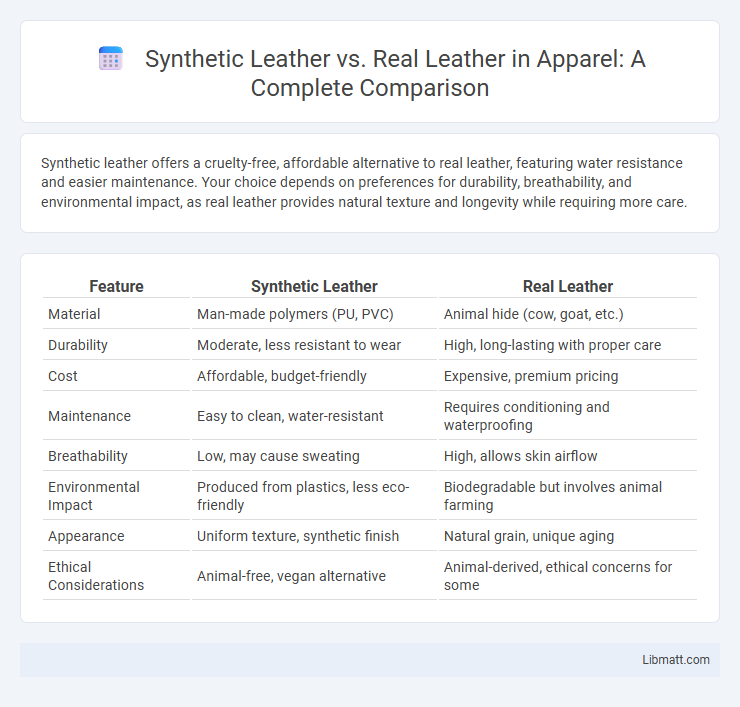Synthetic leather offers a cruelty-free, affordable alternative to real leather, featuring water resistance and easier maintenance. Your choice depends on preferences for durability, breathability, and environmental impact, as real leather provides natural texture and longevity while requiring more care.
Table of Comparison
| Feature | Synthetic Leather | Real Leather |
|---|---|---|
| Material | Man-made polymers (PU, PVC) | Animal hide (cow, goat, etc.) |
| Durability | Moderate, less resistant to wear | High, long-lasting with proper care |
| Cost | Affordable, budget-friendly | Expensive, premium pricing |
| Maintenance | Easy to clean, water-resistant | Requires conditioning and waterproofing |
| Breathability | Low, may cause sweating | High, allows skin airflow |
| Environmental Impact | Produced from plastics, less eco-friendly | Biodegradable but involves animal farming |
| Appearance | Uniform texture, synthetic finish | Natural grain, unique aging |
| Ethical Considerations | Animal-free, vegan alternative | Animal-derived, ethical concerns for some |
Introduction to Leather: Synthetic vs Real
Synthetic leather is a man-made material crafted from plastic-based substances, designed to imitate the look and feel of real leather while offering enhanced durability and resistance to water and stains. Real leather is derived from animal hides, providing natural breathability, unique texture, and aging characteristics that synthetic alternatives often cannot replicate. Your choice between synthetic and real leather depends on factors like sustainability preferences, budget, and desired appearance or performance.
Defining Synthetic Leather
Synthetic leather, also known as faux leather or vegan leather, is a man-made material designed to replicate the appearance and texture of real leather. It is typically produced using polyurethane (PU) or polyvinyl chloride (PVC) layered onto a fabric base, offering durability and water resistance. Synthetic leather serves as a cruelty-free and cost-effective alternative, widely used in fashion, upholstery, and automotive industries.
What is Real Leather?
Real leather is a natural material derived from the tanned hides of animals, predominantly cows, known for its durability, breathability, and unique grain patterns. It undergoes processes like tanning and finishing to enhance its strength and aesthetic qualities, making it a preferred choice in high-quality furniture, fashion, and automotive interiors. The inherent characteristics of real leather, such as its ability to develop a patina and its resistance to wear, distinguish it significantly from synthetic alternatives.
Production Processes Compared
Synthetic leather is produced using a combination of polyurethane (PU) or polyvinyl chloride (PVC) applied to a fabric base, typically polyester or cotton, through processes like coating or lamination, enabling mass production with consistent texture and color. Real leather is crafted from animal hides through complex tanning procedures such as vegetable tanning or chrome tanning, which involve chemical treatments to preserve the hide, enhance durability, and develop a unique grain pattern. The production of synthetic leather is more environmentally controlled but relies on petrochemical resources, while real leather involves resource-intensive animal farming and longer processing times but results in biodegradable, natural material.
Durability and Longevity
Synthetic leather offers moderate durability but tends to degrade faster than real leather, often showing signs of cracking and peeling within a few years of regular use. Real leather provides superior longevity, developing a unique patina and becoming more supple over time while maintaining structural integrity for decades. The higher resilience of real leather against wear and tear makes it a preferred choice for products requiring extended lifespan and robust performance.
Environmental Impact
Synthetic leather production involves petroleum-based materials that contribute to significant carbon emissions and plastic pollution, whereas real leather processing requires large amounts of water and chemicals, leading to environmental contamination. The biodegradability of real leather is higher, but its tanning process often releases toxic substances into ecosystems. Choosing sustainable alternatives like plant-based or recycled leather can reduce environmental footprints associated with traditional synthetic and real leather.
Cost Differences
Synthetic leather typically costs 30-50% less than real leather, making it a budget-friendly option for your wardrobe or furniture. Production of synthetic leather involves cheaper raw materials like polyurethane or PVC, while real leather requires costly animal hides and extensive processing. This significant price gap makes synthetic leather a popular choice for consumers seeking style without the high investment of genuine leather.
Aesthetics and Texture Comparison
Synthetic leather offers a consistent and uniform appearance with a smooth texture that can be customized to mimic various leather grains, while real leather displays natural variations and a rich, complex texture that develops a unique patina over time. Your choice may depend on whether you prefer the flawless finish and wide range of colors found in synthetic options or the authentic feel and aging character of genuine leather. Both materials provide distinctive aesthetic qualities, but real leather's tactile depth often appeals to those seeking traditional craftsmanship and luxury.
Maintenance and Care
Synthetic leather requires minimal maintenance, needing only regular wiping with a damp cloth to remove dirt and occasional application of a conditioner to prevent cracking. Real leather demands more intensive care, including cleaning with specialized leather cleaners and periodic conditioning to maintain its suppleness and prevent drying or cracking. Proper maintenance extends the lifespan of both materials but real leather's natural fibers necessitate more careful and consistent attention.
Ethical Considerations
Synthetic leather offers a more ethical alternative to real leather by reducing animal cruelty and minimizing the environmental impact associated with livestock farming. Real leather production often involves animal slaughter and contributes to greenhouse gas emissions, deforestation, and water pollution from tanning processes. Choosing synthetic leather supports cruelty-free fashion and promotes sustainable resource use, aligning with growing consumer demand for ethical products.
Synthetic leather vs real leather Infographic

 libmatt.com
libmatt.com